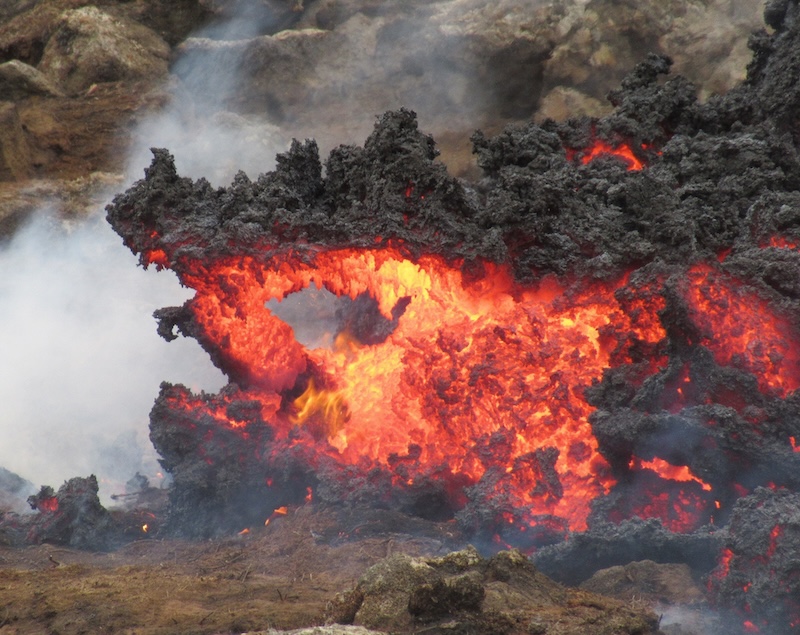Free and exclusive discount codes for hundreds of tours and & travel services in Iceland
Subscribe to instantly receive discount codes for tours, car rental, camper van rental, and outdoor clothing rental. Thank you! ❤️ Jon Heidar, Editor of Stuck in Iceland Travel MagazineDaníel Páll Jónasson, a geographer and avid photographer, has embarked on a remarkable journey through Iceland’s recent eruptions in Iceland. After the 2021 eruption in Geldingadalir, Daníel published a book featuring 112 of his favorite photographs from that first eruption. But now, after two eruptions, forty physically demanding trips to the eruption sites, and some sixteen thousand photos taken, Daníel is crowdfunding an even bigger photography book titled Fagradalsfjall 2: The Fires Are Spreading. The new book features stunning images from all three eruptions on the Icelandic crowdfunding platform Karólina Fund. His pictures are truly spectacular. Although Daníel Páll subscribes to the same philosophy as I do about photography: ‘showing up and taking hundreds of photos,’ I can, however, never hope to match his talent for capturing timeless moments, his grit and perseverance.
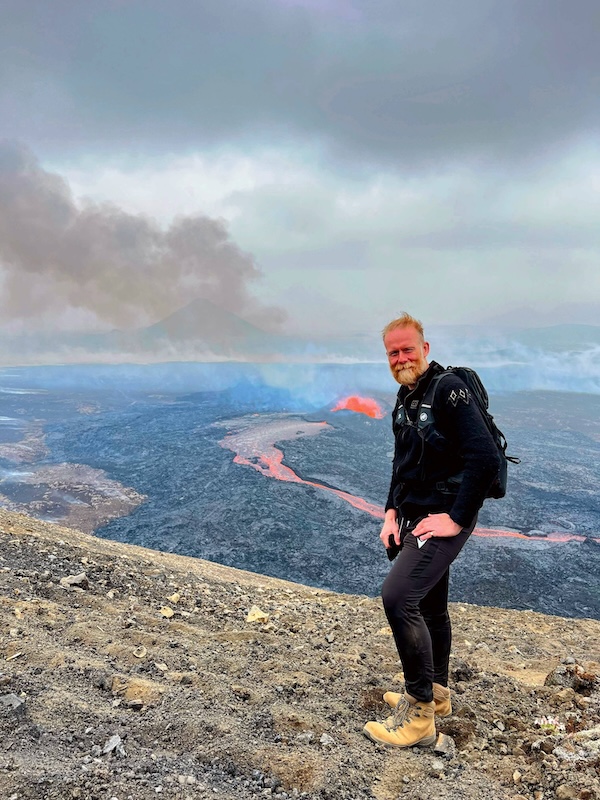
The culmination of an incredible effort to document the recent eruptions in Iceland
Daníel’s new book, featuring 190 of the best and most engaging photographs from his 40 trips to all three eruption sites, is a testament to his passion for nature’s raw power. It will provide detailed travel descriptions, geological explanations, and a touch of humor, all woven seamlessly with the photographs.
The first three chapters of the new book cover the eruptions in Geldingadalir in 2021, Meradalir in 2022, and Litli-Hrútur in 2023. The fourth and final chapter shows how the lava field looks today, and selected photos from the eruptions are shown for comparison. Each chapter begins with a map showcasing the locations of all images within, serving as a handy guide for those planning their volcanic expeditions. Daníel delves into the backstory of each photograph, revealing the intriguing and amusing moments behind the lens. Furthermore, the book offers concise explanations of geological concepts for those interested in the science behind the eruptions. His dedication to documenting Iceland’s volcanic beauty culminates in this photo book, offering readers a chance to relive these breathtaking eruptions and appreciate the profound forces of nature that shape our world.
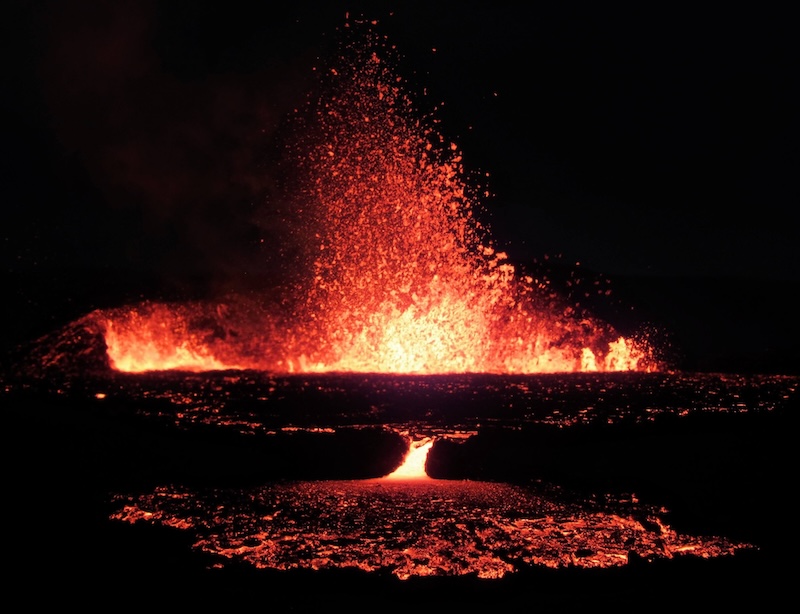
Hey Daníel Páll, I imagine you are busy with the crowdfunding project being almost complete, so thank you for taking the time for this interview. What initially drew you to photography, and how did you become interested in capturing volcanic eruptions?
I have traveled around Iceland every year since I was a child, and ever since I got my first camera, I’ve tried to capture the incredible landscape all around the country. However, I’m only a hobby photographer with a rather keen eye, and initially, I only took photos of the eruption to post on Facebook for my family and friends. When the praise for my photos kept pouring in, I decided to visit the eruption site more often, not just for fun but to document the eruption for a photography book.
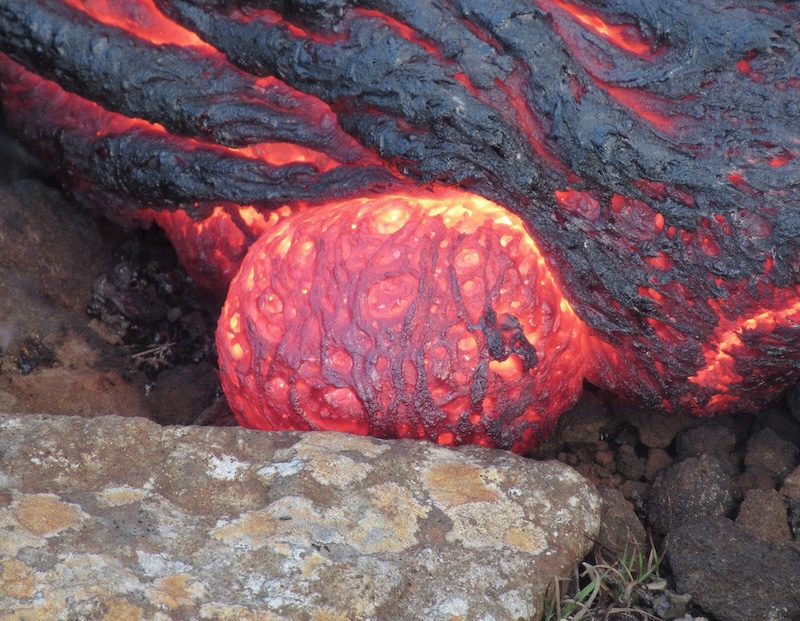
Your selection process for the photos of the three eruptions in Iceland must have been rigorous
I have captured over 16,000 photos of the three eruptions, so the selection process was highly time-consuming for both books. Even if many of the pictures were taken of the same phenomena, and at the same time, to try and capture the “perfect” shot, I still had to browse through all these photos to select the best ones. It was not a tedious process; quite the contrary, I relived many fun moments through all these photos.
You have been up to the three eruption sites 40 times. What comes to mind when you think about these places and the eruptions
I’m incredibly thankful to have had the opportunity to witness this new landscape being born by those eruptions in Iceland. Whenever I see an old crater or lava field, I think, “It must have been awesome seeing this happen,” future generations will probably feel the same about Fagradalsfjall. I’m very fond of this place, as I know it like the back of my hand, and I will continue to hike in the area for decades to come just to relive the spectacular moments I’ve had there.
Your new book covers all three eruptions that have taken place in a relatively small area on the Reykjanes peninsula. What differentiates these events from each other?
The first eruption, in Geldingadalir 2021, was the most photo-friendly one. It changed many times and showed nearly all the volcanic phenomena you could wish for in a lava eruption. It was also fortunately located in a deep valley so that you could see it from all sides. And the lava fountains were incredible! When they were the most powerful, I almost lived on site.
In 2022 and 2023, the later eruptions were not as easy to photograph since the hike was much longer, and it was impossible to walk around the eruption site. In 2022, the lava flowed on the lava from 2021, making it impossible to get up close to much of the lava flow, and in 2023, gas emissions and wildfires made it dangerous to go close to the crater. But it was still a wonderful and exciting experience to hike to these later eruptions, although the first one is still my favorite.
Can you describe your creative process when selecting and composing your photographs of eruptions in Iceland? What techniques or equipment do you use?
My equipment is not fancy, and I’ve always used the same small and relatively inexpensive camera from 2017, Canon PowerShot SX620 HS, with a 25x optical zoom. The zoom lens allows me to “get up close” to the craters, lava lakes, flows, and lobes. At times, I have even used the camera on my phone to capture some magnificent moments!
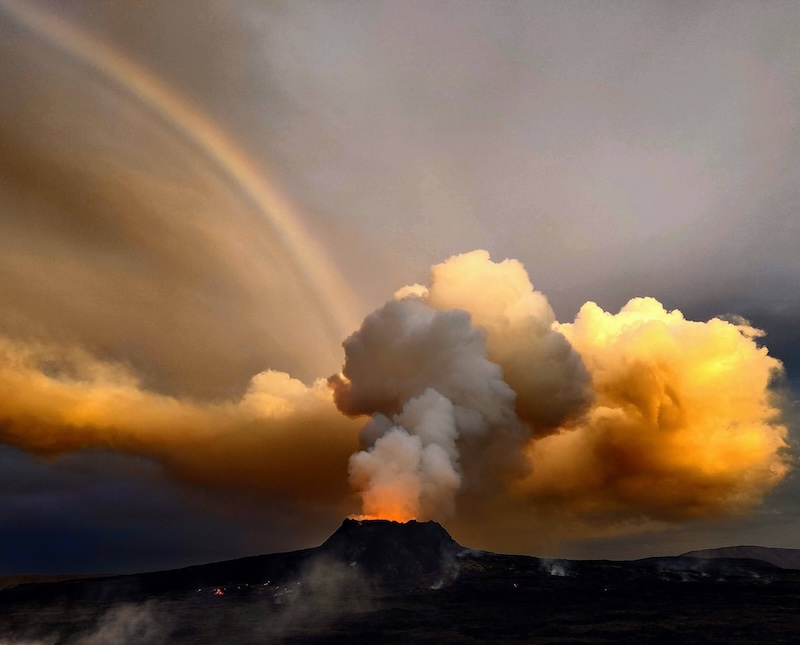
Having great equipment is vital for most photography, but sometimes it’s more important to be at the right place and time with a fast and easy-to-use kit. My most “famous” photo of the rainbow falling into the active crater was taken with my phone because I was holding it while checking my messages. Had I not used the phone, this photo would never have existed since the rainbow was gone a few seconds later.
My selection process differed quite a lot between books. I selected the most beautiful photos for the first book and then came up with the text later. For the second book, which includes much more text, I captured and selected the photos based on the “story” I wished to tell.
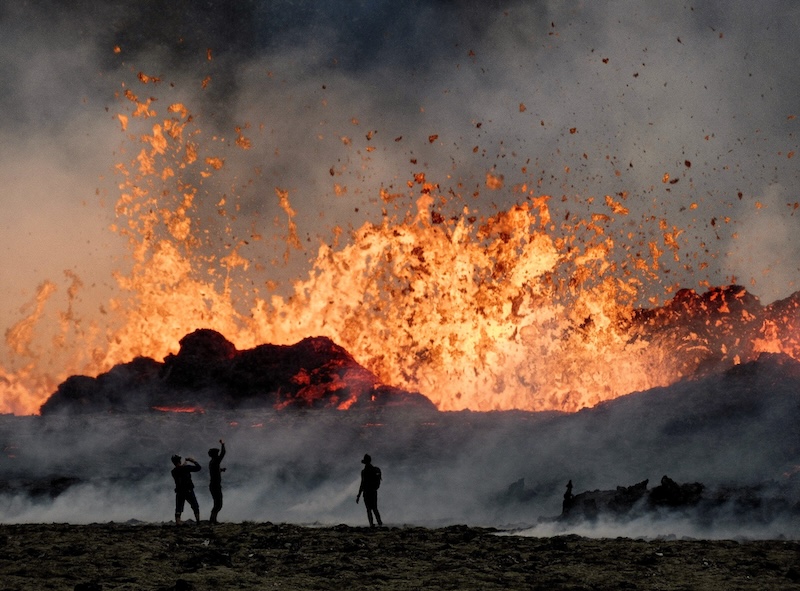
What challenges or obstacles did you face while photographing the eruptions, and how did you overcome them?
There were many challenges photographing the eruptions in Iceland because when photographing eruptions, you must be careful not to injure or kill yourself. The lava itself is dangerous, of course, but there are other “hidden” dangers, such as the deadly gasses that accumulate in depressions in the landscape and deep cracks that form during earthquakes. The hike was long and strenuous, especially during the last eruption, so I always wore good hiking clothes and had plenty of snacks and liquids. I forgot to bring enough snacks and drinks once, and I’ve never felt more exhausted.
When an eruption has continued, it’s often more challenging to find active lava flow, lava falls, or lava lobes as the lava field has expanded. I often used webcams to decide on the hiking trail so I would find some fantastic spectacles more easily when in the area. Photographing an eruption at the start is also better because it’s easier to get closer to the fissure or the crater(s). It’s usually more powerful then as well.
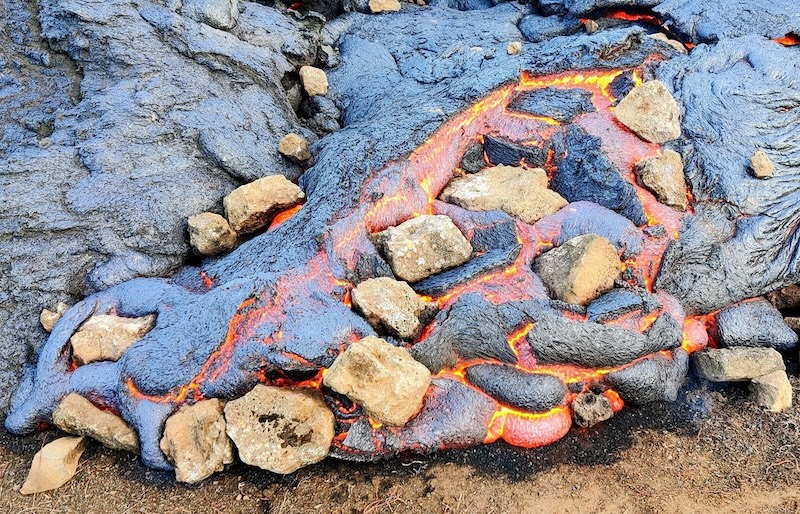
What advice would you give aspiring photographers interested in capturing natural phenomena like eruptions in Iceland?
Just show up, try your best, and take hundreds of photos! Some of them are bound to be good, at least statistically speaking. The right time at the right location is much more important than the equipment you’re holding. And always be ready to photograph amazing moments that only last for seconds. Spending time to set up complex equipment to capture a steady lava lake, lava river, or lava fountains that are sure to be there for some time is fine, but have another camera ready just in case a crater wall collapses or a rainbow falls into the crater, as I witnessed.
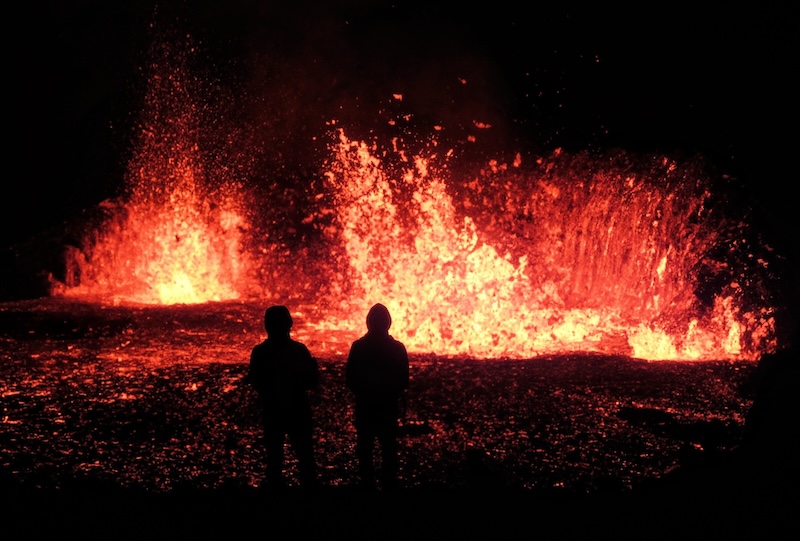
What advice do you have for those visiting Iceland for the first time?
Bring warm clothing and stay here for at least ten days, especially if you plan on visiting some natural wonders far from Reykjavík. The weather can be quite bad for days on end, so if you’ve made plans to visit some sites, don’t expect the plans to hold up perfectly all the time. Always have a backup plan; the museums, clubs, and restaurants are a good substitute if the weather is terrible.
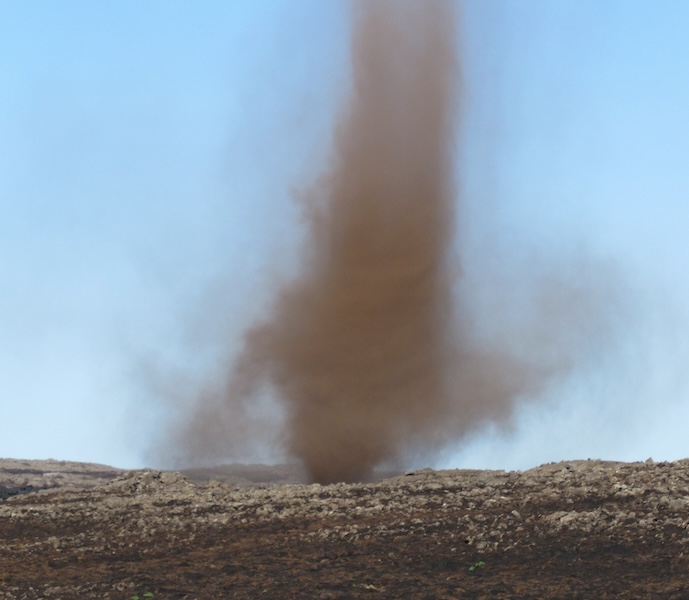
We have all gathered that you are into volcanoes in Reykjanes. What other favorite activities and places in Iceland do you recommend to my readers?
If you’re traveling around the island, make sure to visit the following places: Seljalandsfoss, Þórsmörk, Skógafoss, Lakagígar, Skaftafell, Jökulsárlón, Atlavík, Lónsöræfi, Dimmugljúfur, Laugavellir, Askja (if it is safe), Dimmuborgir, Hljóðaklettar, Ásbyrgi, Dettifoss, Goðafoss, Hvítserkur, the whole of Western Fjords, Snæfellsjökull, Eldborg, Víðgelmir cave and of course Reykjanes. And don’t forget to visit all the cozy little towns by the seaside.
This was quite the list, but there’s a reason I recommend staying here for at least ten days. Our “little” country has too much to offer, so I rarely travel overseas. We have nearly everything right here! Except for some sun and warmth, but being a redhead, I’m not a big fan of either.
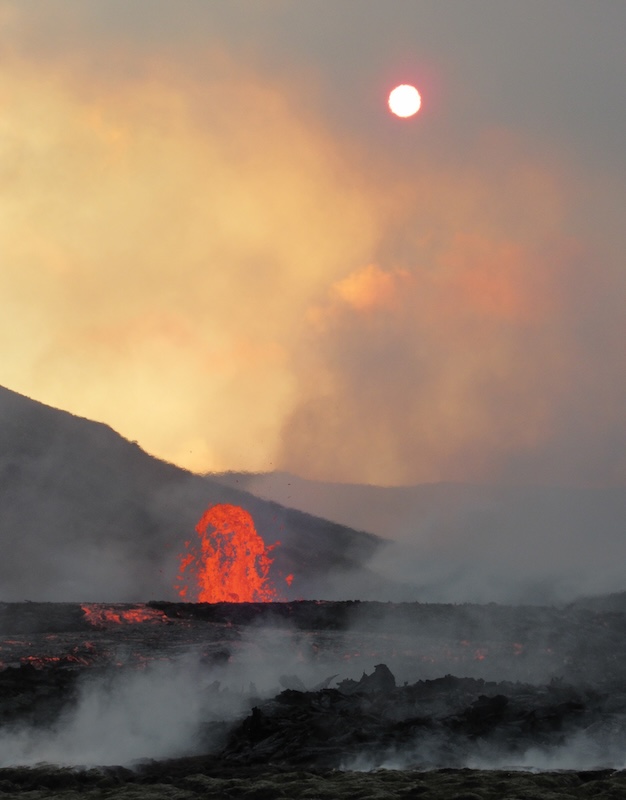
What’s next for you in your photography and exploration of Iceland? Can you share any upcoming projects or expeditions with my readers?
My next project will include being a little bit lazy and relaxing with my family if I’m honest. These last few months have been somewhat crazy, and I want a little off-time when this book project ends. But that might all change if and when Fagradalsfjall, or any other volcano on the island, decides to wake up. All fatigue and desire to relax seem to disappear whenever that happens, and I am gifted with some magical extra energy. And although I desire some relaxation right now, I just can’t wait for the next eruption. It’s like a drug!


